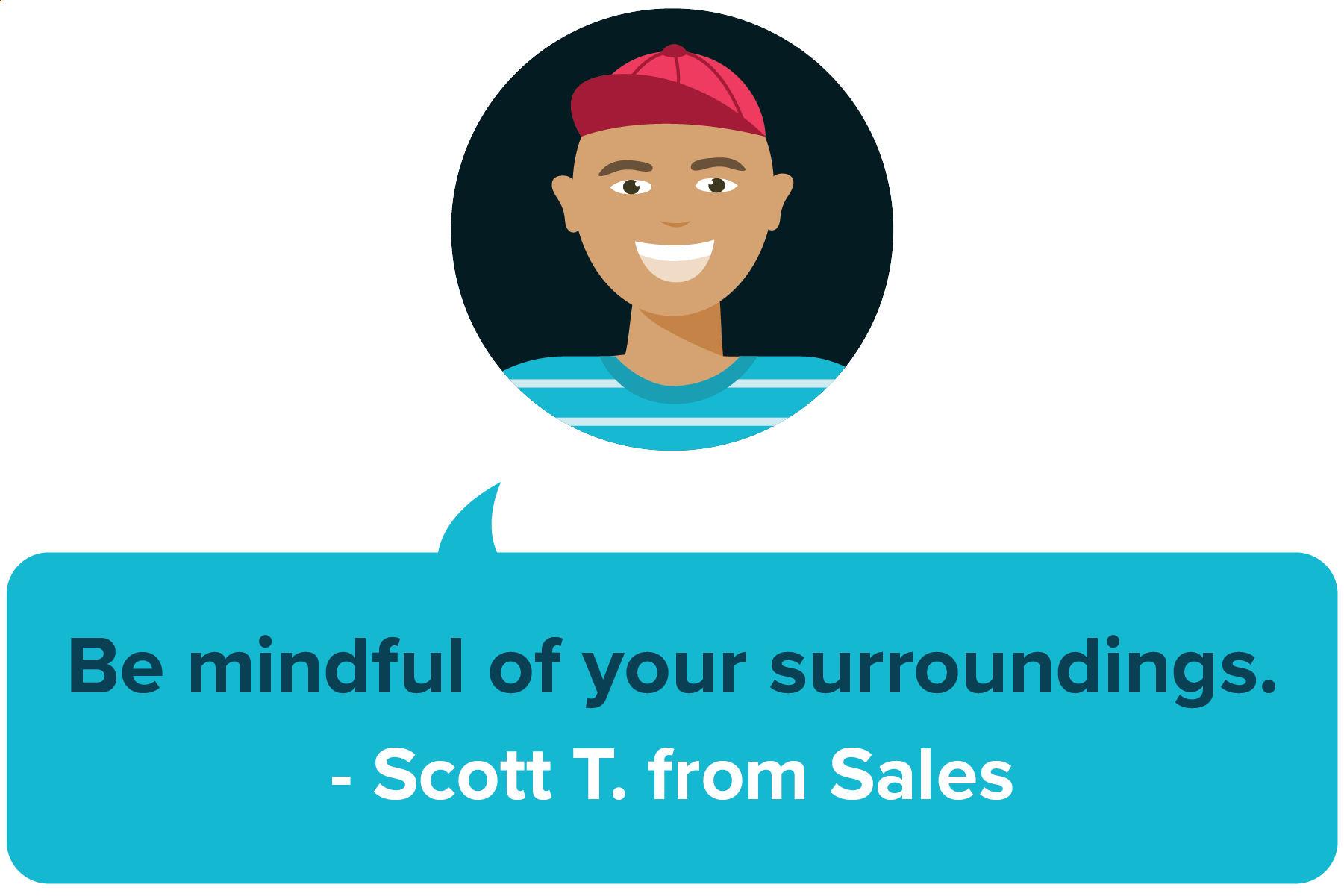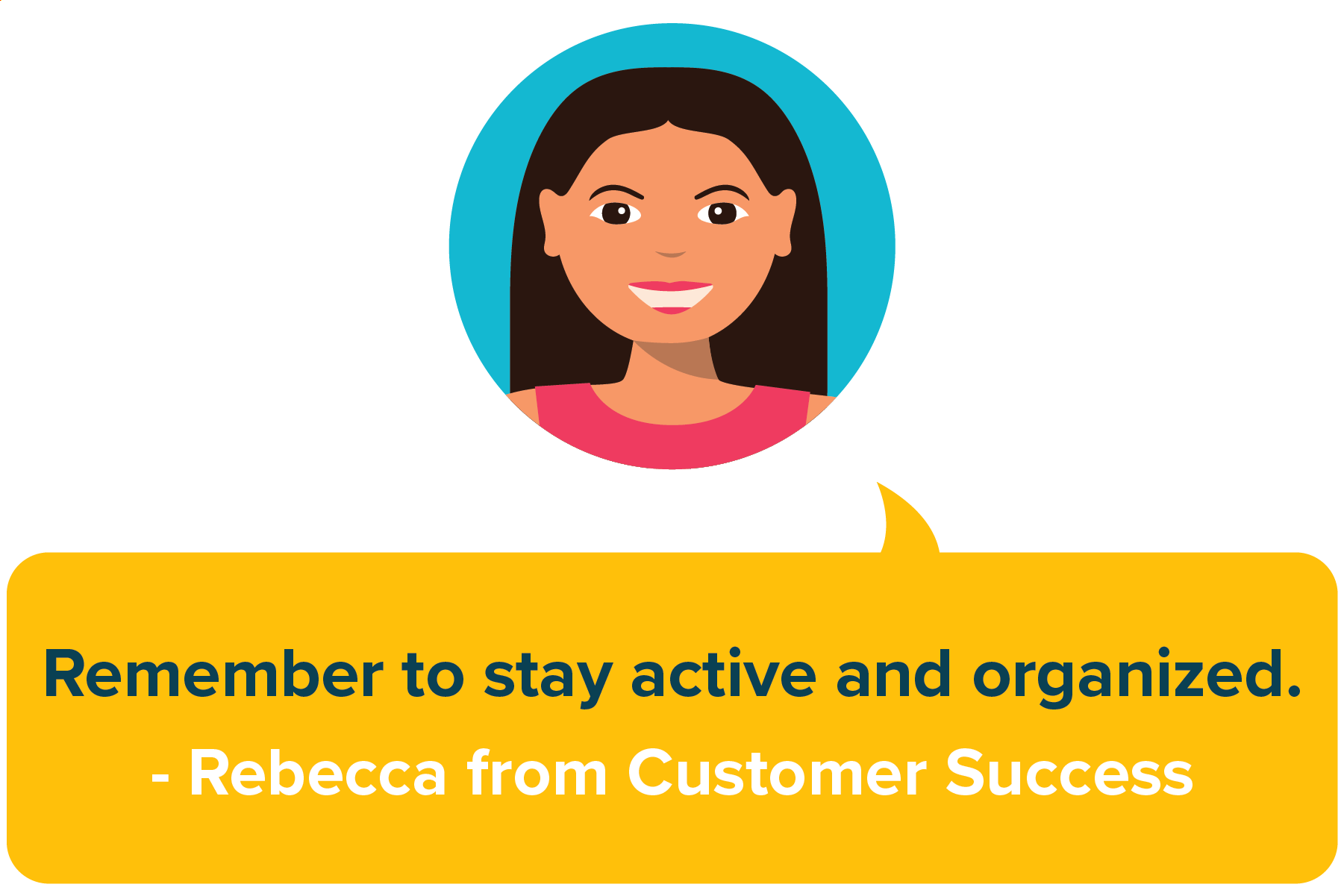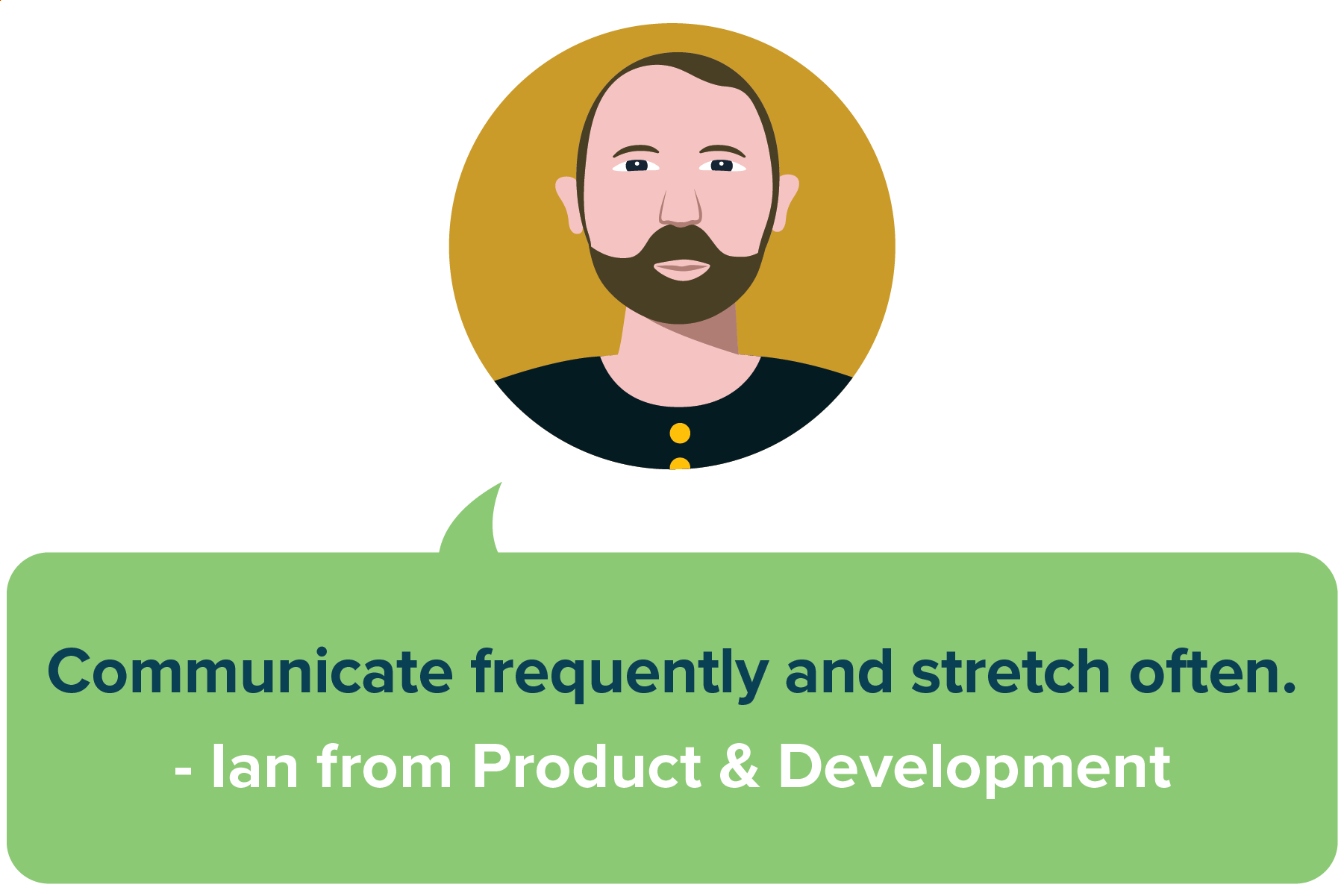Tips for Working Remotely: 6 Ways to Keep Your Proposals on Track
March 17, 2020Last updated on October 1, 2024

Remote work has increased more than 1.5x since 2005 and, especially in light of recent events, this trend shows no sign of slowing down. In this post, I’m sharing five ways to keep your proposal process productive no matter where your sales team is signing on from, plus members of Team Proposify weigh in with their top tips for working from home.
Check out our colourful virtual backgrounds you can use to brighten up your online meetings, here.
If your morning sales stand-up is now done over Zoom, your sales reps are ringing the bell with a Slack emoji 🔔, or you’ve cut down on meetings entirely, this post is for you.

And you’re not alone. Between 2005 and 2017, the number of people working remotely has increased by 159%. From convenience to productivity to health, there are many reasons and benefits of remote work.
Here at Proposify, we prefer to work in-person. (Proposify Co-Founder and CEO Kyle wrote about the ‘why’ behind this approach a couple of years ago.) But in this season, having the flexibility to work from home has been key to our company’s health, both revenue-wise and personally.
Even with remote work being in the mix more often, our team has still been hitting and exceeding targets and just all-around getting it done. In this post, I’m running down the tips and tools Team Proposify recommends for keeping proposals on track when we’re working remotely.
Dogs not included. (But encouraged!)

Tips for working remotely: 5 ways to keep your team’s business proposals on track
Here are five must-haves for successfully creating proposals while working remotely:
- Set up a content management hub
- Create a solid template design
- Remove any bottlenecks from your proposal workflow
- Use electronic signatures
- Don’t double up on work
1. Set up a proposal content management hub.
Most sales teams, especially sales teams that are working remotely, need a content management strategy for their proposals. A content management strategy helps ensure all proposals are accurate, consistent, and take as little time as possible to prepare and send.
Why do you need an efficient, scalable proposal content management strategy? Well, the statistics don’t lie:
- Consistent branding increases revenue by up to 23%. Consistency creates trust and trust is key to closing bigger deals.
- Effective tech tools save time. B2B organizations that leverage technology effectively prepare their sales documents 47% faster.
- And, since more than half of proposal creators say they collaborate with between 6 and 100 colleagues on a single proposal, it’s in your team’s best interest to make sure it’s easy and efficient to work together on proposal content.
As you have more sales reps working remotely, an efficient proposal content management strategy with a central content hub scales with you. Your central content hub contains all up-to-date information, pricing, images, and branding your sales team needs to pull into proposals.
Simply dumping all your docs into a shared folder doesn’t count, though. It’s disorganized and doesn’t include roles and permissions so everyone can access what they need from that central hub to build proposals, but nothing more or less.
A central content hub with roles and permissions are the key pieces of a proposal creation workflow that allows your team to collaborate effectively and create custom proposals quickly and accurately.
You can read more about remote team content management strategies here and how to build efficient sales doc creation workflows here.
2. Create a solid template design.
With a team working remotely, it can feel like you have a little less control over the details. All those “small” design details in your team’s proposals, from branding and logos to images and flow, are actually big factors in establishing trust with prospects and clients.
As I mentioned above, consistent branding can increase revenue and proposals play a big role in that. And, in turn, proposal consistency helps your team get proposals out quickly and gives you peace of mind that everything going out to clients is up-to-date, correct, and making your brand look good.
A robust, reusable proposal template is like a plain cake doughnut that your sales reps can take and ‘decorate’ with the customized information their clients need to say yes and sign on the dotted line. You know that the finished product looks good and contains the right information and your sales reps don’t need to start from scratch every time.
Here’s an overview of how easy it is to make a template in Proposify:
Step 1: Open the template editor. Pick a template from the gallery, use a previous proposal to make it into a template, or start creating one from scratch. Add and order the sections you want to include in your proposal, from your cover letter or executive summary to case studies and terms and conditions.
Step 2: Design your template to match your branding by adding fonts, colours, headings, and logos.
Step 3: Customize your sections with content. Don’t forget to include variables so that your sales reps can quickly auto-update the text with repeating details like client and company names.
3. Remove any bottlenecks from your proposal workflow.
A sales doc workflow obstacle is a person, a tool, or another part of your process that slows your sales reps down, setting them back, and making it much harder for them to get content in front of prospects.
These kinds of bottlenecks in the process make it difficult for them to win, especially in a competitive situation. Time is money and, as we found in our State of Proposals 2020 report, most sales teams only have less than 55 hours to get their proposal in front of prospects first.
Working remotely will likely magnify any bottlenecks in your proposal creation process. Your team can’t stop by a colleague’s desk to check in on the status of a document or if they’re having trouble with a certain tool they’ll need to get help from you over Slack or email.
There are five common ways that your proposal creation workflow can bottleneck and keep your sales team from sending docs to clients in a timely fashion. We see a lot of Proposify customers coming to us to help them smooth out one or more of these issues. They include:
Quality and control
- Proposal approvals all run through one busy person who has no time to keep up with approval requests.
- The sales leader has no insight and has to constantly check-in to see where deals are.
Collaboration
- The editing and approvals process allows too much room for human error.
- There’s no easy way for multiple people to contribute to the same document.
Inter-departmental tension
- Relying on other departments and teams for whom sales docs aren’t their top priority.
- Marketing wants tight control over branding in proposals but that slows the sales cycle down.
Workload
- Too much manual work is burning reps out.
- One person is responsible for all proposal creation, which isn’t scalable.
Tools
- Software meant to speed up creation actually slows your team down.
- No one uses the tools you’ve put in place and does their own thing, to your sales quota’s detriment.
4. Use electronic signatures.
Electronic signatures aren’t new; in fact, they’ve been around for more than two decades now. Yet somehow sales teams still insist on staying stuck in the ‘80s and ‘90s with time-consuming physical sign-off processes.
Consider this: when we analyzed 1.6 million proposals in the Proposify database, we found that more than a quarter of winning proposals are signed online by the client within 11 minutes. You just can’t get that kind of turnaround with physical pen-and-paper signatures.
What’s more, when your sales team is working remotely, any signed and scanned documents are going to come to their individual email inboxes. This means another step for them to add the files and update the information in your CRM.
However, if you use proposal software with a built-in electronic signature tool, you wouldn’t need to worry about any manual data entry. You’d receive a notification as soon as the client signs, the signed proposal would be available in your dashboard and your CRM and proposal metrics would be automatically updated to show a done deal.
5. Don’t double up on work.
Why do double the work if you don’t have to?
When our team is working remotely (or any time, really) they can make their demo decks, presentations, and other sales collateral right in Proposify. They don’t need to copy content into an external program or spend time making another template to match our branding. It’s all right there.
Then, they use presentation mode to present it to prospects without any on-screen distractions. The best part is that all the interactive features of their sales document are retained in that full-screen presentation mode.
Our Customer Success team uses this often when they’re working with customers to get their team members onboarded. Customer Success Managers (CSMs) can present and, for example, use an interactive form to quickly make note of important customer information. Then all those details are retained in the original document.
(Plus, it doesn’t hurt to mention that our research showed proposals that include these forms to corral those pesky-but-pertinent administrative details close 65% faster than those without.)
Team Proposify’s helpful hints for working from home
I chatted with some of my colleagues to find out how they make working from home (WFH) work for them. Spoiler: keeping to schedules, limiting distractions, and making time to move were common themes.
Here’s what our Proposify WFH pros said:

Scott's advice for working from home:
- Having a dedicated space is important to limit distractions. I use our den for calls because in a relatively small apartment it’s an area where I can tune out everything else going on and not be distracted or worry about dishes, laundry, snacking, etc.
- Being mindful of how much you’re working is important, too. Because you’re in your comfort zone and have less human interruptions, I find you can start working as soon as you get up (for me, that’s 6am) and end up working into the evening because there’s less of an obvious quitting time than you get in an office setting where leaving the office signals your day is done (for most people).

Rebecca's advice for working from home:
- I use team messaging software like Slack to stay connected. And I don’t always just share work stuff; I share some fun things, too (when it makes sense to do so).
- I take advantage of lunch breaks to get moving. I do a little workout to make sure I’m not sitting still too long.
- I keep my workspace clean and tidy, just like I would if I were at the office.

Ian's advice for working from home:
- I over-communicate what I’m doing with my team. If I’m doing anything that affects them, I put it in Slack.
- I definitely try and move around regularly. Like some pushups or yoga stretches every hour or so.
- I behave as if I am going into the office. So I start and end my day at the regular time I work when I come into the office. I also take lunch regularly at 12 pm every day.
Conclusion
Of course, getting proposals out to prospects is just one of the challenges that your sales team may encounter when working remotely. This is a good opportunity to start thinking through this and any other barriers to remote work that might be lurking in your processes and procedures.
For example, if you’ve been slacking on putting together the tools your team needs to work from home effectively, now’s the time to make sure your communication style, deadline expectations, and sales tech stack work for your team—no matter where they may be working.
Because when it comes down to it, your prospects don’t care whether your sales team sends a proposal from their desk at the office or their dining room table at home. It should be business as usual for your business in either case, especially for anything client-facing like proposals.
After all, dogs can’t keep morale and productivity up forever.



